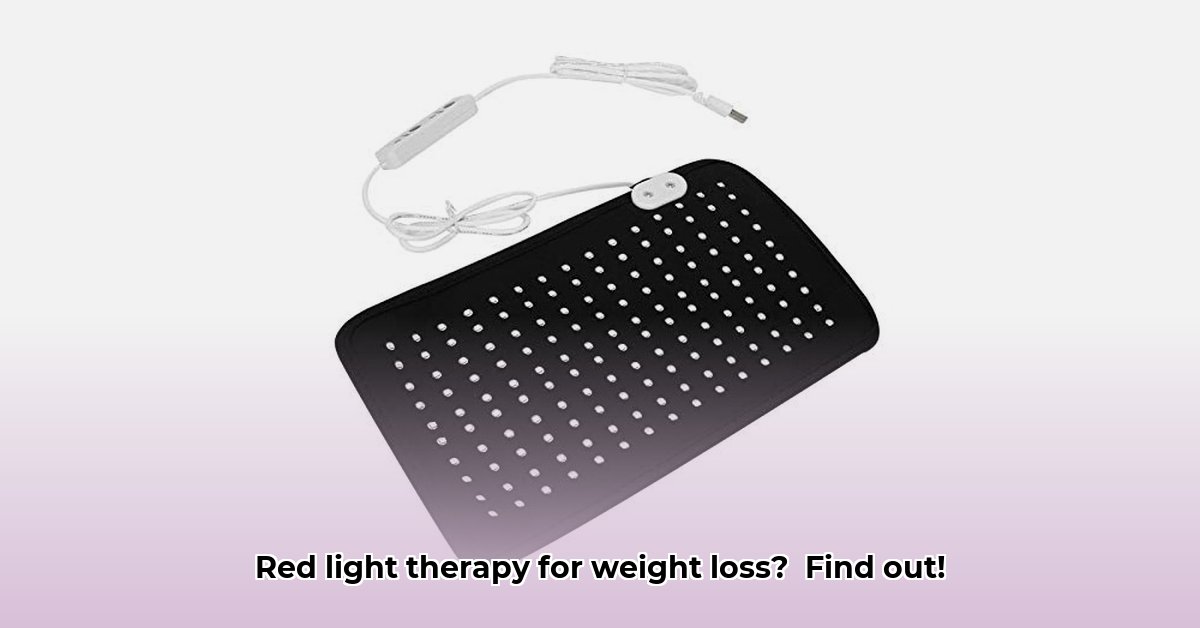
Losing weight without strenuous effort is appealing, but claims surrounding red light therapy (RLT) pads require careful scrutiny. This review examines the scientific evidence for RLT's efficacy in weight loss, separating fact from hype to provide actionable insights.
Understanding Red Light Therapy (RLT)
RLT, also known as low-level laser therapy (LLLT), uses low-intensity red or near-infrared light to potentially stimulate cellular processes. The purported mechanism involves influencing fat cells, but the exact biological processes remain unclear. This is a non-invasive approach, but its effectiveness for weight loss requires rigorous examination. Does it live up to the hype? The research offers a complex answer.
What the Research Shows: A Cautious Assessment
Studies on RLT for weight loss present mixed results. Some show modest, localized fat reduction, meaning slight decreases in specific areas, such as the waist or thighs. However, these results often lack statistical power due to small sample sizes and inconsistent study methodologies. Dr. Anya Sharma, a dermatologist at the University of California, San Francisco, cautions, "While some studies suggest a small reduction in localized fat, the variability in results necessitates larger, more rigorously designed studies to confirm any clinical significance." A lack of long-term data further limits our understanding of its sustainability. The inconsistent findings prevent us from making strong claims about its overall effectiveness. Furthermore, many studies lack diversity in participants, limiting the generalizability of the results.
Does this mean RLT is ineffective? Not necessarily. However, the existing evidence does not strongly support its widespread use for weight loss. The current data is insufficient to draw definitive conclusions.
How Might RLT Affect Fat Cells?
The precise mechanisms through which RLT might impact fat cells are still under investigation. One hypothesis suggests that the light may temporarily alter fat cell membranes, potentially leading to a reduction in their size. However, this is a theoretical explanation needing further research to confirm its role in observed localized fat reduction. The complexity of cellular processes means other factors may also play a part.
Who Might Benefit?
Most existing research focuses on individuals with a body mass index (BMI) between 25 and 30. It's uncertain how effective RLT would be for those outside this range. Furthermore, the relative lack of diversity in study participants raises questions about the generalizability of findings across diverse populations. This highlights the need for broader and more inclusive research.
Weighing the Pros and Cons
Before considering RLT, a balanced assessment of its potential benefits and drawbacks is crucial:
| Pros | Cons |
|---|---|
| May lead to modest, localized fat reduction | Limited, inconsistent research; lack of robust, large-scale studies and long-term data |
| Non-invasive, painless procedure | Expensive; often not covered by insurance |
| Potentially improves blood circulation and reduces inflammation (separate from weight loss) | Results vary significantly between individuals; effects may be subtle and temporary |
| Requires consistent use for any potential benefit; may not be a significant weight-loss solution |
Taking Action: A Practical Approach
Consult Your Doctor: Discuss RLT with your doctor or dermatologist to determine its suitability for your individual health status and needs.
Manage Expectations: RLT is not a standalone weight-loss solution. It should not replace a healthy diet and regular exercise.
Prioritize Lifestyle Changes: A balanced diet and regular physical activity are fundamental for sustainable weight management.
Budget Wisely: RLT can be expensive. Assess the cost versus the potential, limited benefits before investment.
The Bottom Line: A Realistic Perspective
While some studies suggest RLT may lead to modest localized fat reduction in specific groups, the current evidence is insufficient to strongly support its widespread use for weight loss. The research lacks the robustness needed for definitive conclusions. A holistic approach encompassing diet, exercise, and informed medical advice remains the most effective strategy for sustainable weight management. Future research could clarify RLT's role, but currently, it should not be considered a primary weight-loss solution.
How Effective Is Red Light Therapy for Weight Loss Long Term?
Key Takeaways:
- Limited evidence supports significant, long-term weight loss with RLT.
- Studies show modest, localized fat reduction, but results are inconsistent and lack statistical power.
- Larger, better-designed, long-term studies are needed to determine its efficacy.
- RLT is expensive, potentially making it an impractical solution for many.
- Lifestyle changes (diet and exercise) remain crucial for successful, sustainable weight management.
Understanding RLT's Long-Term Impact
As Dr. David Lee, a leading researcher in photobiomodulation at Stanford University, states, "While preliminary findings suggest a potential effect, long-term studies are needed to validate the sustainability of any weight loss observed with RLT." The lack of robust long-term data significantly limits our understanding of its true effectiveness as a weight-loss strategy. The high cost coupled with the uncertain long-term benefits makes it a less viable option than lifestyle changes.
Alternative Approaches: Prioritizing Lifestyle Changes
Weight loss should primarily focus on a healthy diet and regular physical activity. While RLT might offer a supplementary, minor role, it cannot replace the foundational importance of lifestyle changes. A balanced approach prioritizing these cornerstones remains crucial for sustainable weight management. Consider RLT only after establishing healthy habits and in consultation with your physician.